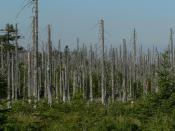Acid rain is a form of air pollution in which airborne acids produced by power plants and factories fall to Earth in the form of acidic rain. The acidic nature of this rain causes widespread damage to our environment. The formation of acid rain begins with the production of sulfur dioxide and nitrogen oxides from the burning of coal, natural gas, and oil, by certain manufacturing plants. Sulfur dioxide and nitrogen oxides react with water and other chemicals in the air to form sulfuric acid, nitric acid, and other pollutants. These acidic pollutants travel with the wind for hundreds of miles, and eventually reach the ground mixed with rain, or sometimes even snow or fog.
Acid rain has caused damage mostly in eastern North America and throughout Europe, as well as parts of Japan, China, and Southeast Asia. Acid rain removes nutrients from soils, slows the growth of trees, and makes lakes uninhabitable for fish and other animals living in it.
In cities, acid rain damages buildings, sidewalks and even water pipes, acid rain falls into drains that flow into streams, lakes, and marshes, making their waters grow suddenly more acidic, this also affects drinking water.
Acid rain can also affect wildlife populations, if a population of plant or animal is affected by acid rain, it may affect animals that feed on the affected species and ultimately, an entire ecosystem may become endangered. Some species that live in water, like fish and water turtles are highly sensitive to acidity, while others are not; frogs can generally survive more acidic water as long as they have an adequate supply of insects to feed on.
Studies show that it is safe to swim in even the most acidic lakes; however, certain minerals taken from the soil can pollute lakes and ponds,

![Copper mining and sulfuric acid plant, Copperhill], Tenn. (LOC)](https://s.writework.com/uploads/3/32663/copper-mining-and-sulfuric-acid-plant-copperhill-tenn-loc-thumb.jpg)
